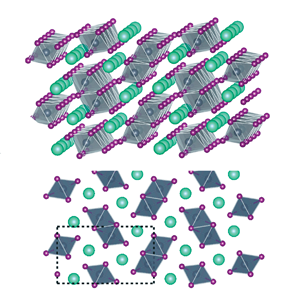Published online by Cambridge University Press: 11 November 2020

Triiodide perovskites CsPbI3, CsSnI3, and FAPbI3 (where FA is formamidinium) are highly promising materials for a range of optoelectronic applications in energy conversion. However, they are thermodynamically unstable at room temperature, preferring to form low-temperature (low-T) non-perovskite phases with one-dimensional anisotropic crystal structures. While such thermodynamic behavior represents a major obstacle toward realizing high-performance devices based on their high-temperature (high-T) perovskite phases, the underlying phase transition dynamics are still not well understood. Here we use in situ optical micro-spectroscopy to quantitatively study the transition from the low-T to high-T phases in individual CsSnI3 and FAPbI3 nanowires. We reveal a large blueshift in the photoluminescence (PL) peak (~38 meV) at the low-T/high-T two-phase interface of partially transitioned FAPbI3 wire, which may result from the lattice distortion at the phase boundary. Compared to the experimentally derived activation energy of CsSnI3 (~1.93 eV), the activation energy of FAPbI3 is relatively small (~0.84 eV), indicating a lower kinetic energy barrier when transitioning from a face-sharing octahedral configuration to a corner-sharing one. Further, the phase propagation rate in CsSnI3 is observed to be relatively high, which may be attributed to a high concentration of Sn vacancies. Our results could not only facilitate a deeper understanding of phase transition dynamics in halide perovskites with anisotropic crystal structures, but also enable controllable manipulation of optoelectronic properties via local phase engineering.
Metal halide perovskites are a new class of semiconductors with great promise for a variety of optoelectronic applications. Owing to their soft ionic lattice, halide perovskites often exhibit rich phase transitions between different crystal structures, frequently from the “active” perovskite phases to undesirable “inactive” non-perovskite phases. Understanding and controlling this transition is vital for developing stable, high-performance devices. However, there is limited understanding on how different symmetry, crystal structure, and defect would impact such a phase transition process. In this report, in situ optical micro-spectroscopy is used to systematically investigate the phase transitions from non-perovskite to perovskite phases in individual CsSnI3 and FAPbI3 wires. Compared to the transition from an edge-sharing octahedral non-perovskite structure to a corner-sharing perovskite structure in CsSnI3, the activation energy for the FAPbI3 phase transition is relatively small, indicating a lower energy barrier when starting from a face-sharing octahedral structure in FAPbI3. The high concentration of Sn vacancies is probably responsible for the much higher phase propagation rate in CsSnI3 when compared to a CsPbBrxI3–x system with the same crystal structure but different halide vacancies. Our experimental results expand the knowledge of phase transition in halide perovskites and offer important guidance toward rationally designing more stable and efficient perovskite devices.